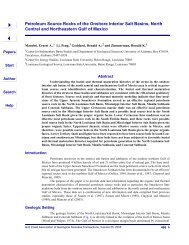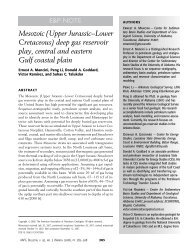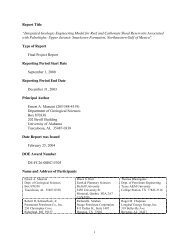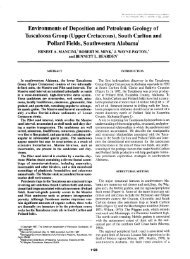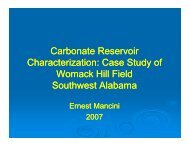Part 4 - Berg - Hughes Center
Part 4 - Berg - Hughes Center
Part 4 - Berg - Hughes Center
Create successful ePaper yourself
Turn your PDF publications into a flip-book with our unique Google optimized e-Paper software.
crevasse splay, and interdistributary bay facies were common, and in the upper Hosston a<br />
marginal marine delta-fringe system existed.<br />
The predominant arenaceous siliciclastics of the Hosston range from<br />
claystones/shales, siltstones, very fine-grained sandstones to conglomerates resulting in<br />
prolific hydrocarbon reservoirs that can be found from Texas, across Northern Louisiana<br />
and into Mississippi (Beckman and Bloomer, 1953; Cullom et al., 1962; Gorrod, 1980;<br />
Saucier et al., 1985; Garner et al., 1987). The thickness of the Hosston varies from a few<br />
hundred ft to over 3,500 ft in Jackson Parish. Minor limestones and conglomerates, as<br />
well as some lignites, are also present in the Hosston (Granata, 1963; Saucier et al. 1985).<br />
In the Pine Island field, Caddo Parish, the non-marine beds of the Hosston are located<br />
between 3,900 and 5,900 ft in depth. Hosston reservoirs can be reached at drilling depths<br />
of less than 10,000 ft (3,000 m) over most of the productive trend in Texas and<br />
Louisiana. The thickness of the Hosston ranges from a few hundred feet near the zone of<br />
truncation in south Arkansas to over 3,500 ft in southern Jackson Parish, Louisiana<br />
(Cullom et al., 1962). Accompanying the change in thickness there is also a change in<br />
character of the formation from predominantly coarse red sandstones, often cherty,<br />
interbedded with red shales in south Arkansas, to finer grained white sandstones and<br />
siltstones interbedded with gray, green and red shales and oolitic limestones in the deeper<br />
parts of the North Louisiana Salt Basin.<br />
In Texas, the Travis Peak Formation (Hosston equivalent) was deposited as a<br />
complex of fluvial and deltaic systems that rapidly prograded over a broad, shallow shelf<br />
more than 100 miles (160 km) wide. Aggradation resulted in braided stream deposits that<br />
were more than 2,000 ft (600 m) thick. The entire complex is considered a fluvial-deltaic<br />
361




